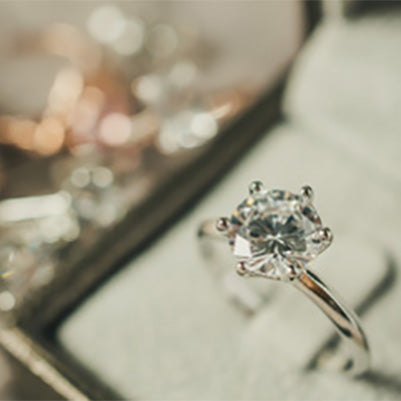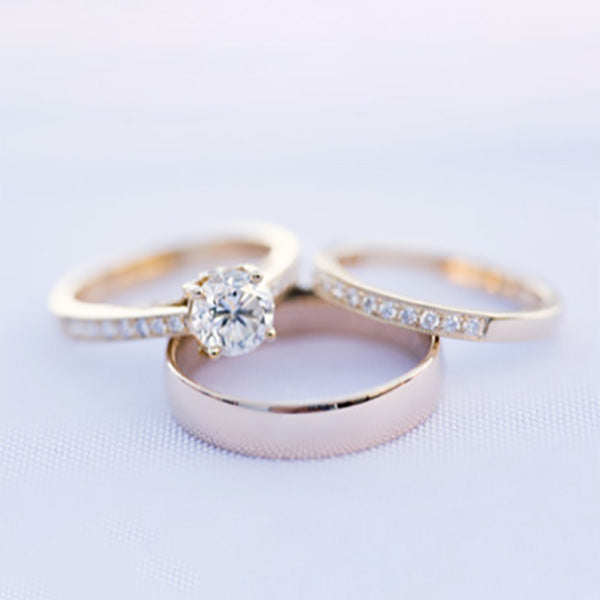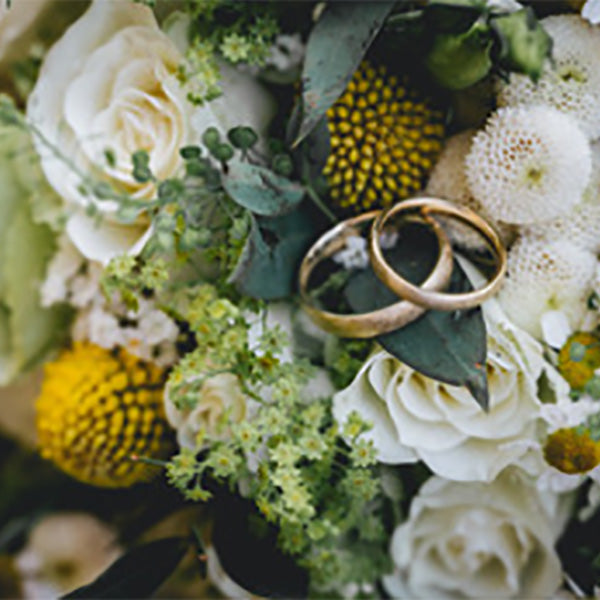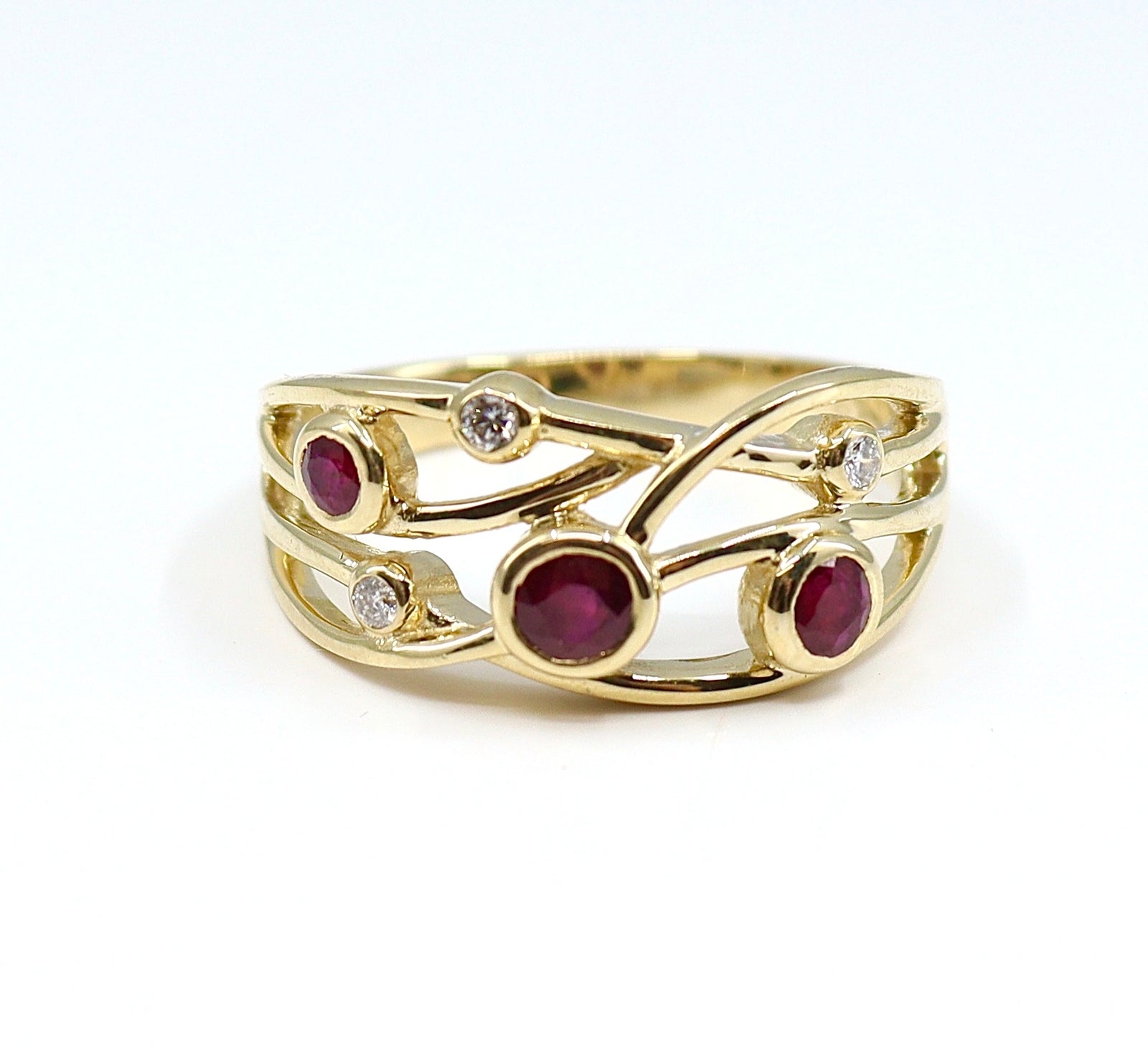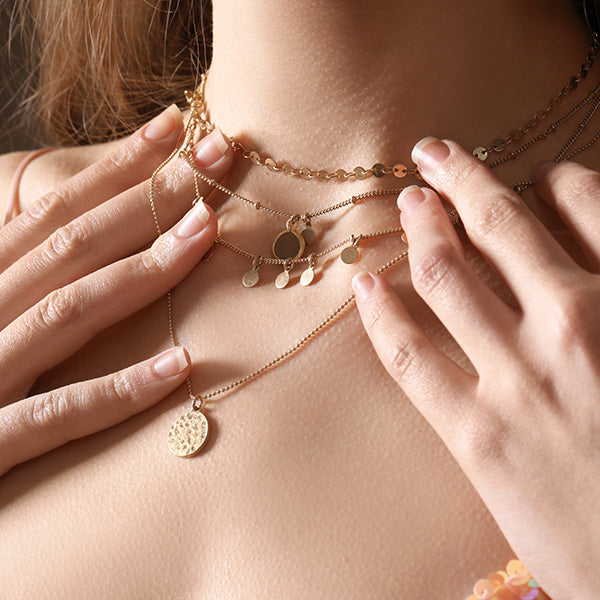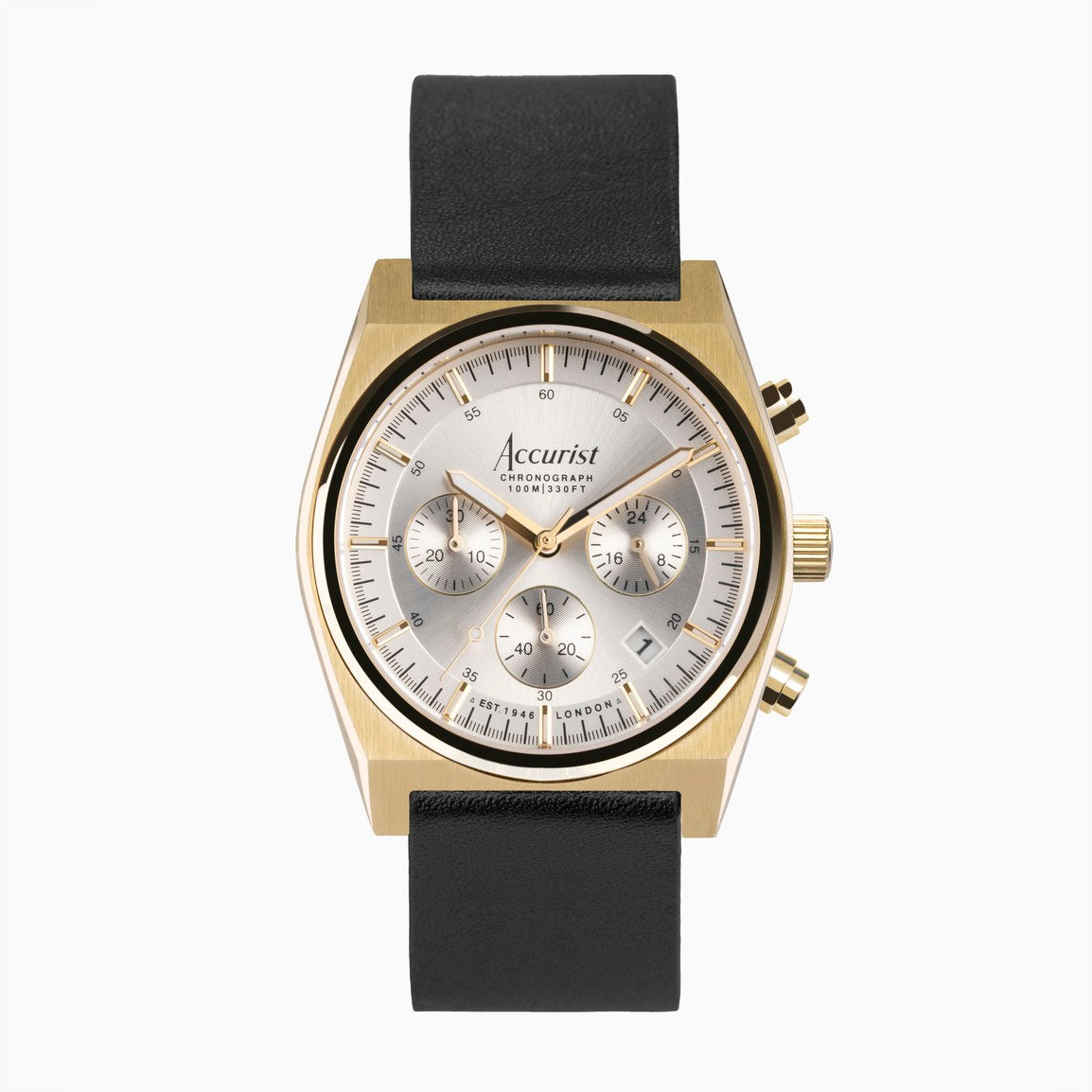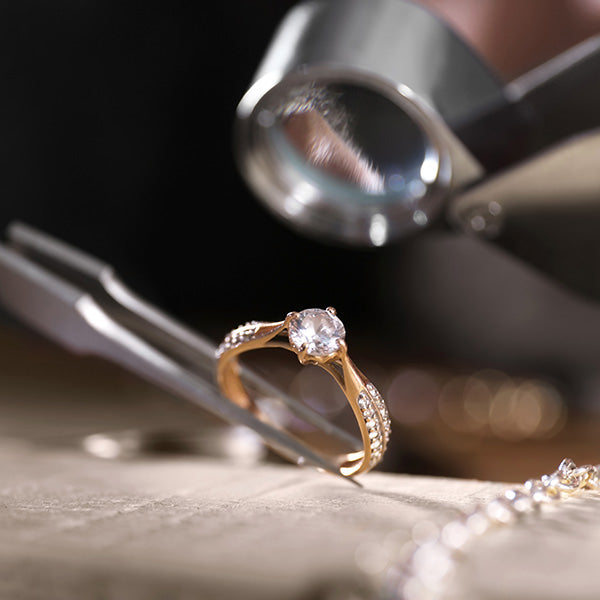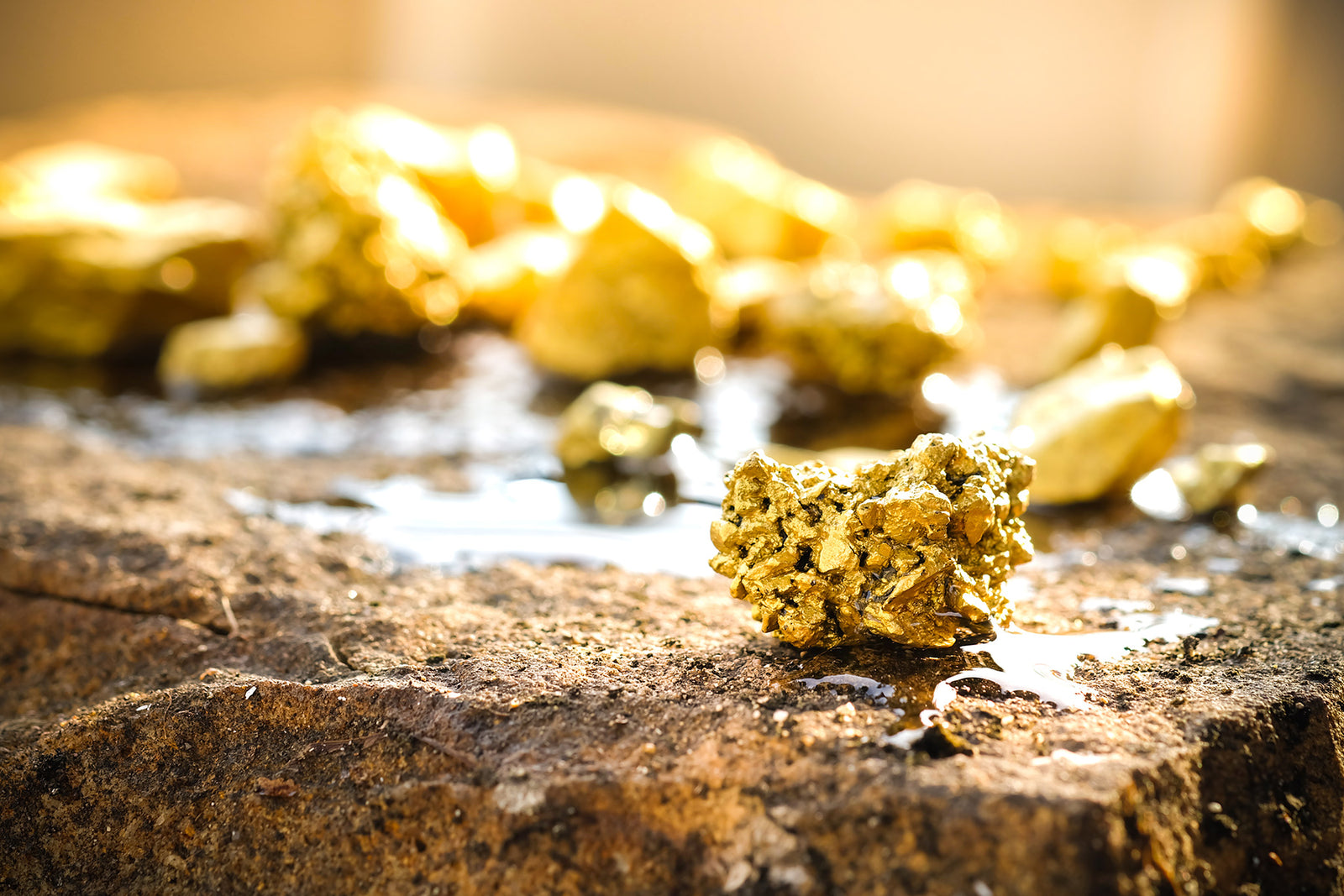All about the precious metals we work with
As working jewellers, we work with a range of different precious metals. Each one has its own unique characteristics and each has its place in jewellery design.
Gold
Gold has been mined since before 4000 BC, and in the ancient world the Egyptians were the main producers. In the new world, there are many different countries that have produced high levels of gold. Gold is a rare metal.
Pure gold (24 carat) is a very soft metal and not ideal for jewellery, it is so soft that it can easily be beaten out into a very thin sheet. In India pure gold is particularly prized, and wearers of pure gold bracelets find they have to reshape them by hand every day because the metal is so soft. So, we would suggest that 24 carat gold can't really be used for jewellery that is subject to a lot of wear, such as an engagement ring. Gold is therefore normally alloyed with other metals such as zinc to add hardness. The proportion of gold to alloys is defined by the carat number which measures the parts of gold out of a total of 24.
Gold's price fluctuates every day and is bought and sold as a commodity. In times of economic uncertainty, the price of gold (and all precious metals for that matter) tends to become higher as gold is thought of as a safe haven for money.
Gold is a very inert metal (i.e. it does not react well with other things) and this means that it won't tarnish (i.e. react with the atmosphere) like silver, and therefore maintains its wonderful yellow colour.
9ct yellow gold
9 carat gold is 9 parts in 24 (or 37.5%) pure gold. It is a paler yellow colour as compared with richer 18 carat gold and tends to be a little harder. 9ct gold is a pale yellow colour
18ct yellow gold
18 carat gold is 18 parts gold in 24. It is a richer, darker yellow colour as compared with 9 carat gold.
22ct yellow gold
22ct yellow gold is often thought of as 'pure gold' - it is extremely rare to get jewellery any purer than this as it would not be practical for the purpose. As 22ct gold has only a small proportion of other metals, you might find the ring is slightly softer than other carats.
How to care for yellow gold rings
Over time, the ring may dull from contact with detergents, moisturisers and other chemicals - ideally you would take the ring off as needed to protect it from such substances. If it does dull then even a quick buff with a soft cloth should brighten it up. Gold will show scratches from every day wear and tear; the first few will be the most obvious but over time it will develop a more pleasing finish. We can repolish/refinish the ring for you should you ever want to remove any deep scratches, we can usually do this the same day for you.
White gold
White gold is one of our best-sellers, particularly for diamond-set rings - the beautiful white colour is often considered to provide a better backdrop for diamonds than yellow gold. White gold was first used in jewellery in the 1920s, closely following the popularity - and rarity - of the similarly coloured platinum
White gold is yellow gold that has been alloyed with other metals such as silver, palladium and platinum to give it a warm white coloured metal.
All gold used in engagement rings is alloyed with other metals to make it a harder metal and suitable for setting gemstones and diamonds into, it’s the choice of these other metals that affect the colour of the gold. The proportion of gold to alloys is defined by the carat number (which measure the parts of gold out of a total of 24) in the same way that yellow gold is defined.
9ct white gold
9 carat white gold is a slightly yellowy white colour as compared with 18 carat white gold.
18ct white gold
18 carat white gold is longer lasting, more durable than 9ct white gold. It is a brighter ‘white’ than 9ct white gold.
White gold and rhodium plating
As gold is normally yellow, the white sheen is achieved by alloying the gold with another metal such as palladium, platinum or silver; and then plating the ring with rhodium. The more gold that is contained in the alloy, the more yellow the 'white' gold will appear in colour, meaning that 18ct white gold is naturally more yellow than 9ct. This is why white gold rings are traditionally plated with rhodium - to get the whitest possible finish. Rhodium also helps protects the ring from wear and tear - if silver is used in an alloy, it could become tarnished by the air, and rhodium is more resistant.
How to care for white gold rings
Like anything, white gold will develop small scratches. These will be most noticeable at first but will fade over time to a more pleasing finish. If the ring picks up any surface dirt, you can rinse this off under cold water and dry the ring carefully with a soft cloth. The shine of the ring may dull from contact with detergents, moisturiser and soaps so even a quick buff with a soft cloth will improve the appearance of the ring. The rhodium plating will wear off over time, but this should happen gradually and fairly evenly. If the ring becomes too yellow for your liking, you can send it back to us for re-plating which we can usually do the same day for you.
Rose gold
Gold that is alloyed with copper is called rose gold. The alloy is sometimes also known as red gold or pink gold. Rose gold was popular in Russian jewellery in the 19th century and is making something of a comeback in modern times as people are thinking about using more interesting precious metals and stones in their engagement rings.
Gold used in engagement rings (or any jewellery for that matter) is alloyed with other metals to make it harder and more suitable for everyday wear. This is true of rose gold as much as ordinary yellow gold and so the purity of rose gold is measured in carat in exactly the same way as the purity of yellow gold is measured. 18 carat rose gold is 18 parts gold with 6 parts alloy (i.e. out of a total of 24 parts).
9ct rose gold
The 9 carat alloy is a beautiful pinky colour and our most popular choice.
18ct rose gold
18 carat rose gold is a much darker metal with a more pronounced yellow tinge to it - this is due to the extra proportion of yellow gold to copper
How to care for rose gold rings
Rose gold rings may dull over time from contact with detergents, moisturisers and other chemicals - ideally you would take the ring off as needed to protect it from such substances. If it does dull then even a quick buff with a soft cloth should brighten it up. Rose gold will show scratches from everyday wear and tear; the first few will be the most obvious but over time it will develop a more pleasing finish. We can re-polish/refinish the ring for you at any time, usually the same day.
Platinum
Platinum is the most expensive and hard wearing of the precious metals and a wonderful contemporary steely-white colour. The combination of diamond and platinum in an engagement ring is a wonderful sight and unsurpassed in brilliance. Platinum does not tarnish and its purity means that it will not cause an allergic reaction when in contact with the skin.
Platinum's strength makes it an ideal metal to set the most valuable of stones into and is an ideal choice within which to set a diamond.
Platinum's expense is, amongst other things, due to its rarity. As platinum is rare, the world's supply will eventually become exhausted. Platinum extraction is not environmentally friendly, however it does have many other uses, for example it is of high importance in the medical industry, including use in medical equipment. The most common platinum alloy in wedding rings is 950, which means the platinum has a purity of 95%. .
Platinum’s name is derived from the Spanish word ‘platina’ when it was discovered in South America by the newly arriving Spanish in the 16th century.
How to care for platinum rings
Platinum is the strongest precious metal used in jewellery, however can still incur scratches. The finish (a satin sheen that develops on the surface of a ring produced by daily wear and tiny scratches) is considered by many to be a unique and often desirable attribute, however, the shine and reflective lustre can easily be restored by our jewellers here at Shaw jewellers.
Platinum can be cleaned using shop-bought jewellery cleaner or by soaking it in a warm and mild solution of soap and water. Gently rub the ring with a soft cloth to dry, however this will not remove scratches.
Palladium
Palladium was discovered in the nineteenth century. It has been classified as one of the platinum group metals, which also includes rhodium, iridium and ruthenium. From this group, only palladium and platinum are rare enough to be traded on the world commodities market - and this is why you may see our prices change from week to week.
The UK Assay Office finally launched the palladium Hallmark in July 2009 and since then an increasing number of palladium engagement rings has been made and we have seen a dramatic increase in the use of this metal in our work.
Palladium is mined at the same time as platinum therefore no new mining takes places, so it is often considered a more environmentally friendly choice.
Palladium is in the platinum group of metals, which has the highest melting point. It looks very similar to platinum but is a less dense metal, which means it is a great choice for heavier rings where the customer wants the steely white colour of platinum but doesn't want the weight on their finger.
How to care for palladium rings
Palladium will show some scratches over time but the metal is displaced - not lost - so the metal will not wear down. As the ring ages, the small marks come together to form a finish that most people find pleasant. If you want to restore a ring to its original high polish or matt finish, we can re-polish/refinish it for you.
Palladium can be cleaned using shop-bought jewellery cleaner or by soaking it in a warm and mild solution of soap and water. Gently rub the ring with a soft cloth to dry.

